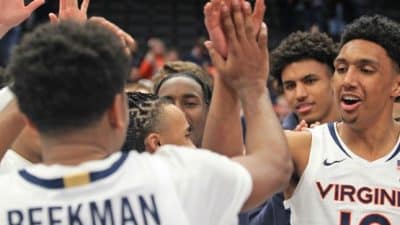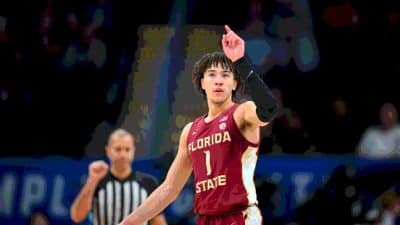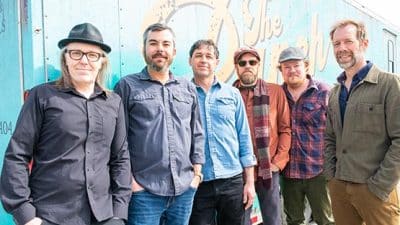
Sports fans know when they hear the letters ACL that the player on their favorite team involved is out for a while, at least the season, if not longer.
The reason: the anterior cruciate ligament, to an athlete, “is one of those things you can’t live without,” said Dr. David Diduch, an orthopedic surgeon at UVA Health.
You can’t just play through an injury to the ACL, which helps stabilize the knee joint. When that ACL is torn, “you really have to put a new ACL back in there,” Diduch said.
“It doesn’t heal itself,” Diduch said. “You can’t sew it together. You can’t just put it in a brace and give it time. None of those things change the outcome. The knee just remains unstable, and when people try to cut, it just gives way.”
The UVA football team lost two key players to ACL injuries in the spring – wideout Lavel Davis Jr. and linebacker Chico Bennett Jr.
When their injuries were announced, it was noted that the hope was to have both back perhaps in November, but speaking from experience – I tore the ACL in my right knee as a senior in high school – a seven-month recovery and return to live game action is probably overly optimistic.
“If you’re talking about surgery into April, you’re that’s really middle of the season, and so that kind of makes it hard,” Diduch said of a possible November return for Davis and Bennett. “And then it becomes, well, is that a wise thing to do?
“I see a lot of athletes that will, I mean, that really doesn’t matter what your level of play high school, college, pro, they’re all eager to get back. But there’s usually a season on going when they’re ready to come back. So, do you come back right at crunch time? Is that a wise thing to do at the tail end of the season, as you’re entering playoffs, and you’re trying to perform at your peak at the same time that your knee is just coming off that injury?
“I wouldn’t say that next season’s out for these guys, but we would just certainly be smart about any kind of release,” Diduch said.
The process has evolved a good bit since my ACL surgery in 1990.
Basically, according to Diduch, the surgery in 2021 involves building a brand-new ACL for the knee joint.
“We’ll take a graft from another part of that person, typically from the tendon that connects the kneecap to the shin bone, and we’ll take a strip of that with a piece of bone from both ends, and then we’ll drill a tunnel from the bottom bone, the leg bone, up into the joint, and then from the inside out, from the inside of the knee up in the thigh bone out, and we try to position those tunnels in a very precise way, right where the old ACL attached,” Diduch said.
With the patella tendon, a surgeon uses screws that dissolve over time, a type of plastic that your body dissolves, and it becomes bone again.
But the process takes time.
“The graft will takes a few months to heal, and then your body gradually kind of incorporates it and turns over that tissue and remodels, and it becomes more like the original ACL. That takes several months to happen, and it takes a while for the muscles to come back,” Diduch said.
The challenge is knowing when a player is safe to go back and play again.
Diduch said UVA Health has developed testing with benchmarks for measured strength, agility, balance and endurance, plus analyzing mechanics for jumping and landing.
“We’ve got a lot of data now on about 1,000 people and a database we can look at for this, and one of the things that still bubbles to the top, the most important, is just time from surgery,” Diduch said.
This is the sober reality for athletes. You can’t just accelerate the rehab process by outworking it.
“It’s usually it’s at least six months,” Diduch said. “The sweet spot often can be a little bit longer than that, closer to nine months, if people are not really rehabbing. It just needs seems to be at least that long. But people that are rehabbing, well, maybe you can accelerate their return to sport to closer to six months.”
Six months to return to sport, not necessarily six months to return to mid-season form.
In fact, it’s almost certainly not six months to return to mid-season form.
You’re really talking six months to be able to get back out there to do basic sports things. Being able to play full speed – cutting, powering through a tackle, going all out on a fly pattern – involves some mental rehab work.
“One of the things that we measure with this database, we have actually a scale that talks about fear of going back to sport, believe it or not,” Diduch said. “There’s a series of questions that are answered, and you get a score, and we can go, OK, this person is more or less just fearful of returning to sport and trusting the knee.”
Again, speaking from experience, the trusting the knee part can be more difficult than the physical part of rehabbing the knee.
“You’d like to think that maybe it depends on, well, how what are they doing in rehab, or what’s their knee exam like, but it’s all over the map,” Diduch said. “That’s the other side of sport, or other side of life, really. And for most of these people, if you really talk to them about their knee, they say it’s a two-year process, that it’s that first year, no matter how hard they worked, it’s just not the same, and the second year, they trust it in a different way, and they’re not thinking about it, and they can put it behind them and really focus on what’s in front of them much better.”
Story by Chris Graham










